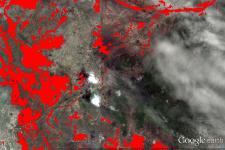United
Nations
Office for Outer Space Affairs
UN-SPIDER Knowledge Portal

The objective of this practice is to determine the extent of flooded areas. The use of SAR satellite imagery for flood extent mapping constitutes a viable solution to process images quickly, providing near real-time flooding information to relief agencies. Moreover, flood extent information can be used for damage assessment and risk management creating scenarios showing potential population, economic activities and the environment at potential risk from flooding,
The practice was applied to the flood event in Malawi in January 2015. Since December 2014, heavy rains affected Malawi causing rivers to overflow. The recommended practices was applied to an affected area in the Nsanje district around Chiromo.
This practice can be applied globally. It has been applied successfully for floods in Australia, Africa and Asia. The precondition for SAR water detection is a smooth water surface. False alarm can occur in areas of radar shadow due to variable terrain. False alarm can also occur with smooth objects like roads and sand. Flood detection in urban areas remains difficult. The detection of flooded vegetation from SAR imagery requires a different approach using two multi-temporal images.
Neither UN-SPIDER nor the Regional Support Offices (RSOs) or their partners take any responsibility for the correctness of outputs from this recommended practice or decisions derived as a consequence.